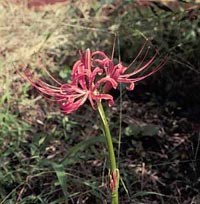Resource Library
Plant of the Week: Spiderlily, Red
The University of Arkansas System Division of Agriculture does not promote, support or recommend plants featured in "Plant of the Week." Please consult your local Extension office for plants suitable for your region.
Plant of the Week
Red Spiderlily
Latin: Lycoris radiata

Some plants have developed a way to cope with the discomfort of the summer heat. The spiderlily is one of them.
The spiderlily is one of these that goes away when summer heat arrives and returns when the weather is a bit more tolerable. As summer winds down, its showy red flowers will be appearing soon in gardens across the South.
The red spiderlily is one of a dozen species of bulbous plants from Asia that are classified as a part of the amaryllis family. Unlike their cousin the daffodil, Lycoris flower in the fall without the hint of leaves, thus giving rise to popular names such as surprise lily, magic lily and naked lady for the group. Three species are most common, L. squamigera - the tall pink species, L. aurea -- the tall golden flowered species, and L. radiata -- the short red flowered species.
Spiderlily grows from round short-necked bulbs that are seldom larger than an inch and a half thick. Leaves emerge in October from bulbs that are about a quarter of an inch wide and 10 inches long with gray-green midveins. The leaves are evergreen during the winter and die with the first hint of warm weather in May.
Coral red flowers are produced in September on 16 inch tall scapes. The top of the scape is crowded with a crown of six to ten blooms with each flower having six petals and long exerted stamens, reminiscent of daddy-long-leg spider legs. The common form of spiderlily is sterile because it is a natural triploid with three sets of chromosomes.
This species is common on roadways and the edges of fields in western Japan, but like many other components of Japanese life it was originally imported from China, probably during the T’ang dynasty about 700 AD. The Japanese keep in touch with the changing seasons by having various plants symbolize the season. The evening news usually features segments on what plants are in bloom throughout the year. Spring, with its cherry blossoms is most important, but many other flowers usher in the various stages of the seasons.
The flower that symbolizes the beginning of fall on the vernal equinox is the red spiderlily. The Japanese name for the plant is "higan-bana" which translates, according to Buddhist theology, as the flower of this life and of the next life. A devout Buddhist will celebrate the fall equinox with a ceremony at the tomb of ones ancestors. Spiderlilies are often planted on the grave as a floral tribute to the dead. Because of this association with the dead the spiderlily is considered unlucky and one would never think of giving a bouquet of these flowers as a gift.
The red spiderlily is an easy to grow bulb that will flourish for years in the garden. This species is should be planted in a location with good drainage and where its foliage will be undisturbed during the winter. I have mine planted in a bed of liriope where the foliage blends nicely. Once established, it can be left for years with minimal care.
By: Gerald Klingaman, retired
Extension Horticulturist - Ornamentals
Extension News - August 25, 2000
The University of Arkansas System Division of Agriculture does not maintain lists of retail outlets where these plants can be purchased. Please check your local nursery or other retail outlets to ask about the availability of these plants for your growing area.